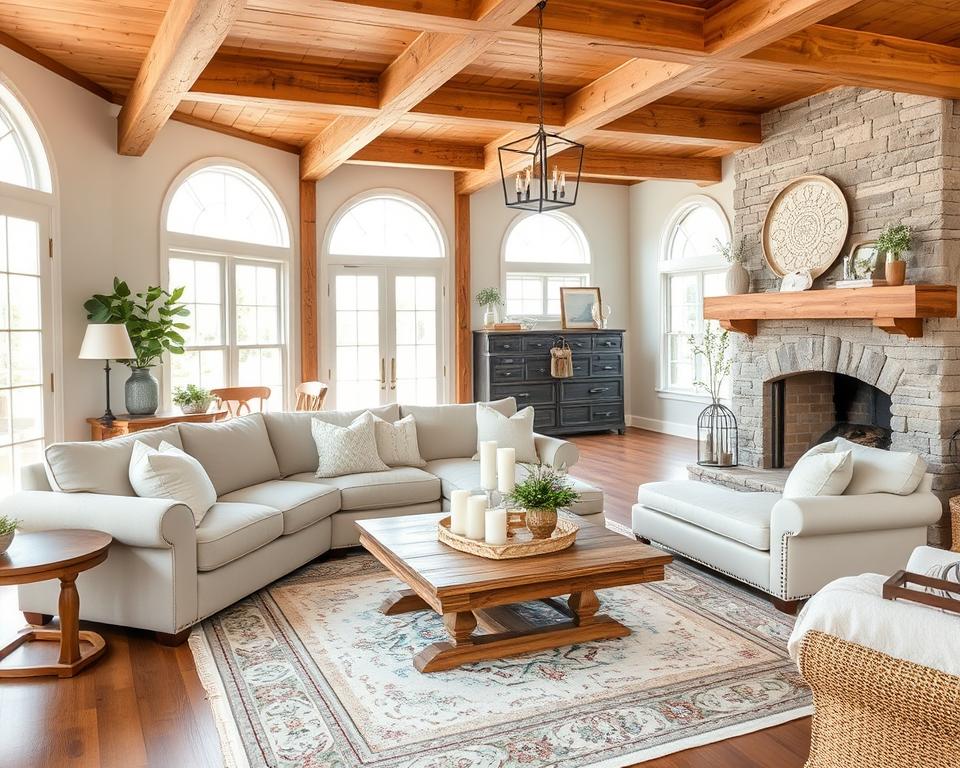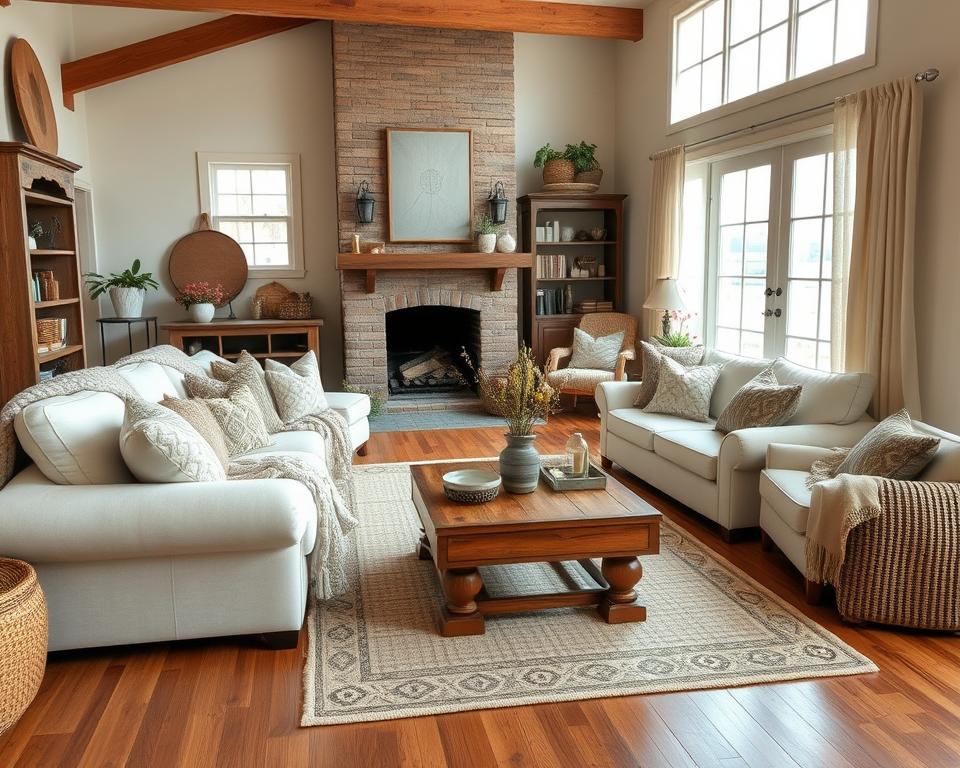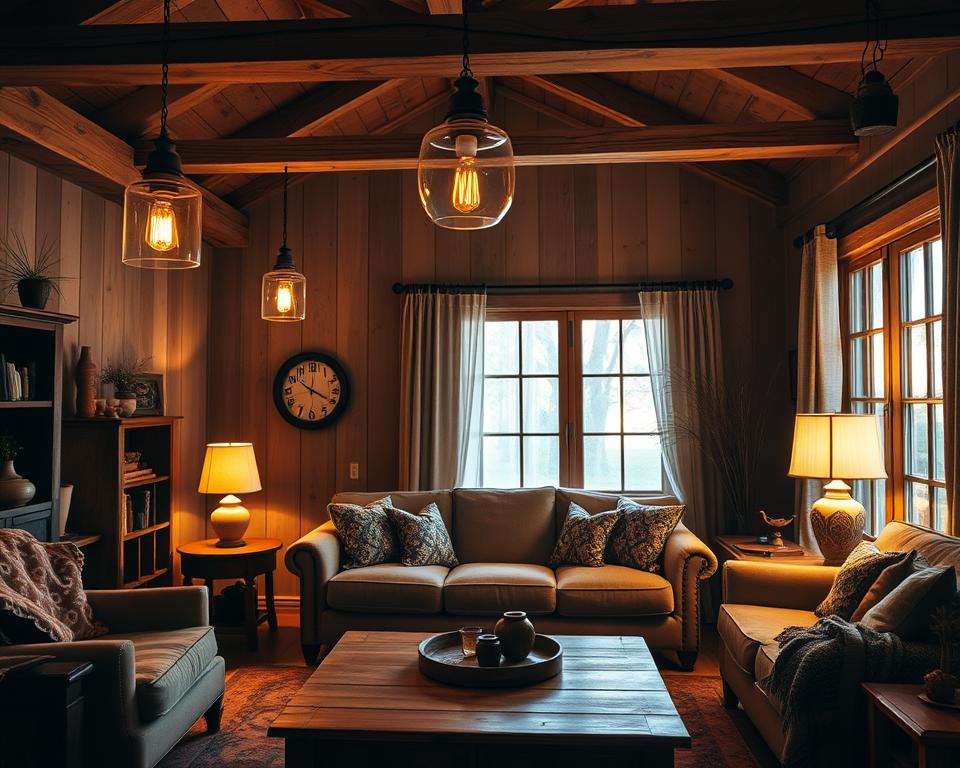Creating a warm and inviting home starts with a well-designed farmhouse living room. This style emphasizes natural materials, neutral colors, and vintage pieces. It aims to create a cozy, comfortable space that feels like home. A farmhouse living room often features 5 key elements: working fireplaces, vaulted ceilings, shiplap walls, built-ins, and exposed beams. These elements set the tone for a polished yet cozy atmosphere.
Picture a room with oversized sofas and plush armchairs, making up about 60% of the seating. It’s adorned with 5-10 decorative items, balancing old and new. This is the essence of a well-designed farmhouse living room. Designers suggest using a focal point, like a stone fireplace or large artwork, to anchor the room. Adding natural materials like reclaimed wood, linen, and cotton enhances the warmth and coziness.
The goal of a farmhouse living room is to blend style with comfort. We’ll explore how to design such a space, incorporating the latest trends and styles. Whether you’re seeking cozy living room design ideas or farmhouse style home decor, we’ve got you covered.
Key Takeaways
- Farmhouse living rooms typically feature 5 key architectural elements, including working fireplaces and exposed beams.
- Oversized sofas and plush armchairs are recommended for comfort, accounting for approximately 60% of seating arrangements.
- Natural materials like reclaimed wood, linen, and cotton are commonly used in farmhouse design.
- A neutral color palette is preferred, with 70% of modern farmhouse enthusiasts opting for a neutral color scheme.
- Cozy textiles, such as throws and pillows, are crucial for achieving a warm atmosphere, with 75% of surveyed homeowners stating their importance.
- Vintage finds and antique pieces can add a unique touch to your farmhouse living room, with 62% of farmhouse kitchens incorporating antique collection displays.
- Outdoor-inspired elements, like weathered benches, can add charm to your farmhouse living room, with 60% of designers recommending their use.
What is Farmhouse Style?
Farmhouse style is a blend of rustic farmhouse decor and farmhouse interior design, evolving over time. It aims to create a welcoming atmosphere, connecting us to the past. This style combines modern and traditional elements, often featuring vintage farmhouse decor and reclaimed materials.
Comfort and practicality are at the heart of farmhouse style. It’s seen in plush furnishings, natural textiles, and warm colors. Elements of nature, like reclaimed wood and plants, add to the outdoorsy feel.
Definition and Key Characteristics
Farmhouse style is marked by natural materials, vintage decor, and cozy furnishings. Key traits include:
- Use of reclaimed wood and other natural materials
- Incorporation of vintage decor and antique pieces
- Emphasis on comfort and practicality
- Use of natural textiles and warm color palettes
Historical Background
Farmhouse style originated in traditional rural architecture and design. It has evolved, blending modern style and functionality with its rustic charm.
Common Variations
There are several farmhouse style variations, like modern farmhouse, coastal farmhouse, and traditional farmhouse. Each offers a unique take on the classic farmhouse look, with industrial decor, nautical themes, and vintage accessories.
| Style | Characteristics |
|---|---|
| Modern Farmhouse | Industrial decor, clean lines, minimal ornamentation |
| Coastal Farmhouse | Nautical themes, light color palettes, natural textures |
| Traditional Farmhouse | Vintage decor, rustic materials, classic furnishings |
Color Palettes for Farmhouse Living Rooms
In a farmhouse living room, the color palette is key to creating a cozy atmosphere. Neutral tones like soft whites, warm grays, and muted beiges are common. They make the room feel larger and more welcoming, ideal for a country chic design.
Modern farmhouse living rooms benefit from accent colors like muted blues, greens, and soft lavenders. These add depth and character to the neutral base. It’s crucial to balance these colors with the neutrals to achieve a cohesive look. This balance ensures the space feels curated and inviting. Natural textures and materials enhance the warmth and depth of the room.
Popular color combinations include shades of green for a subtle, organic feel. Warm gray and goldenrod fabrics add sophistication. Black and white palettes create a sleek, modern look. Warm neutrals like white, gray, navy, brown, and blue bring a traditional touch. These color palettes make the room cozy and inviting, perfect for relaxation and entertaining.
Neutral Tones: The Foundation
Neutral tones like soft whites, warm grays, and muted beiges form the base of a farmhouse living room’s color palette. These colors create a calm, serene atmosphere. They can be paired with various accent colors to add depth and character.
Accent Colors: Adding Vibrancy
Muted blues, greens, and soft lavenders add vibrancy and interest to a farmhouse living room. These colors help create a cohesive look. They can be used in furniture, accessories, and decorative elements.
Seasonal Color Swaps
Seasonal color swaps refresh a farmhouse living room’s look and feel. Incorporating seasonal colors and textures makes the space feel fresh and inviting. Popular seasonal combinations include soft blues and whites for spring, warm neutrals and earthy tones for autumn, and rich reds and greens for winter.
Furniture Choices for a Farmhouse Look
Creating a cozy farmhouse style home requires the right furniture. Oversized sofas and plush armchairs are perfect for snuggling by the fireplace. Adding reclaimed wood and natural materials to your furniture adds rustic charm.
Mixing modern design with traditional pieces is key for a farmhouse look. Farmhouse decorating tips suggest combining sleek lines with curvier designs for a unique feel. Pieces like storage ottomans and coffee tables with storage are great for farmhouse living rooms.
For a cohesive look, consider these tips:
* Mix textures like wood, metal, and fabric in your furniture
* Vintage or antique pieces add character
* Mix different styles and periods for a unique look
* Natural elements like plants bring warmth and freshness
By following these tips and choosing the right furniture, you can create a cozy farmhouse style home. It will reflect your personal style and charm.
Textiles that Enhance Comfort and Style
In the realm of cozy living room design, textiles are essential for adding warmth and texture. Vintage farmhouse decor, with its throw blankets and pillows, significantly impacts the ambiance. The second web source highlights the importance of throw blankets and pillows in creating a cozy atmosphere.
A mix of textures is key in a cozy living room. Consider woven rugs, cozy throws, and patterned pillows. Layering rugs and adding wool or faux fur throws enhance both comfort and style. This approach creates a welcoming space, ideal for a farmhouse interior design.
Cozy Fabrics: Throw Blankets and Pillows
Cozy fabrics like plaids, stripes, and Native American motifs are favored for throw blankets and pillows. These patterns bring rustic charm and coziness. Mixing patterns and textures creates a unique, inviting atmosphere.
Layering Rugs for Visual Interest
Layering rugs adds visual interest and is a common technique in farmhouse designs. A natural fiber rug over hardwood or wide plank floors creates warmth and coziness. This method also defines areas, enhancing the room’s intimacy.
Window Treatments: Curtains vs. Blinds
Window treatments like curtains or blinds are crucial for comfort and style. In vintage farmhouse decor, natural fabrics like cotton or linen for curtains add warmth and texture. Blinds offer a modern, sleek look while controlling light.
| Textile Element | Description |
|---|---|
| Throw Blankets | Cozy fabrics such as plaids, stripes, and Native American motifs |
| Pillows | Patterned pillows in cozy fabrics such as wool or faux fur |
| Rugs | Natural fiber rugs such as jute or wool, layered over hardwood or wide plank floors |
Incorporating Vintage Finds and Antiques
Creating a unique and inviting farmhouse living room involves incorporating vintage finds and antiques. This approach adds character and personality to the space. Rustic farmhouse decor often includes antique furniture, vintage accessories, and antique lighting.
To find authentic pieces, visit antique stores, thrift shops, and flea markets. Online marketplaces and estate sales are also good sources. When selecting vintage items, focus on those in good condition with a unique story. For instance, an antique honey pine hutch or a vintage sideboard can elevate your farmhouse living room’s elegance and sophistication.
Here are some tips for styling vintage finds and antiques in your farmhouse living room:
- Start with a neutral color palette and add vintage pieces as accent items
- Mix and match different styles and periods to create a unique and eclectic look
- Don’t be afraid to refinish or repurpose vintage items to give them new life
Incorporating vintage finds and antiques into your decor makes your space truly unique. With patience and creativity, you can find the perfect pieces to bring your farmhouse living room ideas to life. Balance old and new pieces for a cohesive look. Don’t hesitate to seek out farmhouse decorating tips from experts and online resources.
| Vintage Item | Age | Price |
|---|---|---|
| Antique Honey Pine Hutch | Over 100 years | Varies |
| Vintage Sideboard | 50-99 years | $35.00 – $900 |
Lighting Ideas to Brighten Your Farmhouse Space
In a modern farmhouse living room, lighting is key to setting the mood. A country chic living room benefits from a lighting plan that balances function and style. Farmhouse design often mixes old and new, and lighting is no different.
Industrial fixtures and chandeliers can elevate a farmhouse’s look. For example, a 230-year-old farmhouse kitchen boasts a floral tole chandelier as its centerpiece. This highlights the fusion of traditional and modern in kitchen lighting. Industrial pendants from the 1950s add a unique touch, blending old and new.
Industrial Fixtures and Chandeliers
Industrial fixtures bring history and character to a room. They pair well with natural materials like wood or wrought iron, fitting modern farmhouse design trends. Vintage light fixtures’ long lifespan adds to their value in farmhouse interiors.
Using Natural Light Effectively
Natural light is vital in a farmhouse living room. It makes the space feel larger and more welcoming. Open shelving in kitchens boosts perceived spaciousness and organization, enhancing the inviting atmosphere. Sheer curtains or blinds can filter natural light, creating a cozy ambiance.
Accent Lighting: Wall Sconces and Lamps
Accent lighting highlights specific room areas, like reading nooks or dining tables. Wall sconces and lamps add warmth and coziness, making the space more inviting. Textiles like throw pillows and blankets increase comfort levels, with 70% of people preferring them in their homes.
Seasonal Decor for a Farmhouse Living Room
Incorporating seasonal decor into a cozy living room design adds warmth and personality. For a farmhouse style home, natural elements like greenery, pumpkins, and pine cones are perfect. They create a welcoming atmosphere.
Some popular seasonal decor ideas for a farmhouse living room include:
- Spring: Floral and pastel accents, such as throw pillows and vases, can add a touch of color and freshness to the space.
- Autumn: Cozy textiles, such as knitted wool and flannel, can be used to create throw blankets and pillows. Warm colors and natural elements like pumpkins and leaves add to the cozy ambiance.
- Winter: Festive touches, such as twinkling lights and evergreen branches, can create a magical atmosphere. Cozy textiles and warm colors keep the space feeling snug and inviting.
By incorporating these seasonal decor ideas into your farmhouse living room design, you can create a space that feels cozy and inviting all year round. Keep your decor simple and uncluttered. Don’t be afraid to mix and match different elements to create a look that’s uniquely yours.
With a little creativity and planning, you can create a farmhouse living room that’s perfect for relaxing and entertaining, no matter the season. So why not get started today? See how you can use seasonal decor to enhance your cozy living room design and make your farmhouse style home feel truly special?
| Season | Decor Ideas |
|---|---|
| Spring | Floral and pastel accents, greenery |
| Autumn | Cozy textiles, warm colors, natural elements |
| Winter | Festive touches, twinkling lights, evergreen branches |
Plants and Greenery in Farmhouse Design
Incorporating plants and greenery into farmhouse interior design brings natural beauty into the space. This is crucial for vintage farmhouse decor, aiming to create a warm and inviting atmosphere. By bringing the outdoors in, you achieve harmony and balance in your home.
Choosing the right plants is key in farmhouse decorating. Snake plants, fiddle leaf figs, and pothos plants are popular for their low-maintenance needs and adaptability to various lighting conditions. Succulents and cacti are also ideal for those with busy schedules, needing 90% less water than traditional houseplants.
Here are some benefits of incorporating plants into your farmhouse design:
- Improved air quality: Plants can filter approximately 87% of indoor air pollutants, creating a healthier environment.
- Reduced stress: Studies have shown that having plants in the home can reduce stress levels by up to 30%.
- Increased productivity: Engaging with plants can enhance concentration and productivity by about 15%.
Displaying plants can be done creatively. Using reclaimed materials for planters is a sustainable practice embraced by 60% of plant decorators. You can also use unconventional vessels like vintage teacups and trophies to add personality to your space.
By adding plants and greenery to your farmhouse design, you create a space that is both beautiful and functional. It’s also sustainable. So, why not try it and see the benefits for yourself?
| Plant | Lighting Requirements | Watering Frequency |
|---|---|---|
| Snake Plant | Low-Medium | Every 2-6 weeks |
| Fiddle Leaf Fig | Bright, Indirect | Every 1-2 weeks |
| Pothos Plant | Low-Medium | Every 1-2 weeks |
Tips for Personalizing Your Farmhouse Living Room
As you introduce the farmhouse look to your living room, remember to add personal touches. These should reflect your unique style and cherished memories. Incorporating family heirlooms is a great way to infuse warmth and character into your space. A vintage armchair or a rustic wooden coffee table can add depth and character to your decor.
Creating a gallery wall is another way to personalize your space. Mix framed artwork, black-and-white photographs, and repurposed vintage signs to tell your family’s story. This not only adds visual interest but also showcases your personal style and what you love.
The beauty of farmhouse design is its ability to blend different aesthetics seamlessly. Feel free to mix modern and traditional elements, vintage finds, and contemporary accents. This blend will create a unique, cozy living space that truly feels like your own.
FAQ
What is the definition of farmhouse style?
What are the key characteristics of farmhouse style?
How can I incorporate seasonal decor into my farmhouse living room?
What types of furniture work well in a farmhouse living room?
How can I incorporate vintage finds and antiques into my farmhouse decor?
What are some tips for personalizing a farmhouse living room?
How can I use plants and greenery to enhance a farmhouse living room?
What color palette works best for a farmhouse living room?

Tina Moore is a writer at TrendGaping, dedicated to farmhouse decor and rustic minimalism. With a love for natural textures and vintage charm, she explores topics like distressed wood finishes, cozy interiors, and functional yet stylish design. Her goal is to help readers create warm, inviting spaces that reflect the beauty of country living.



